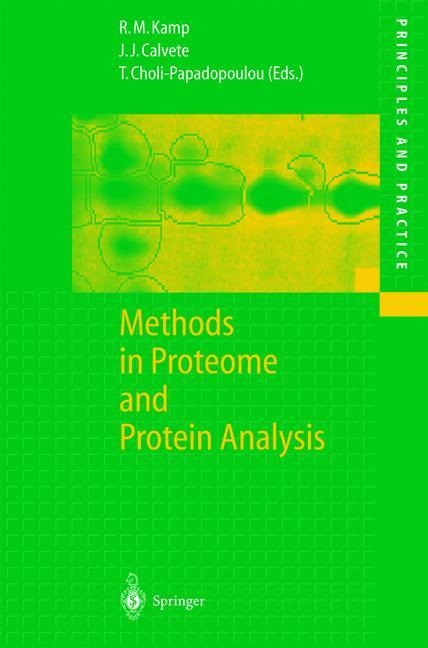Read more
Following the succesful publication of "Proteome and Protein Analysis" in 2000, which was based on a former MPSA (Methods in Protein Structure Analysis) conference, Methods in Proteome and Protein Analysis presents the most interesting papers from the 14th MPSA meeting.
Major topics include: protein and peptide sample preparation and separation; new reagent for protein sequence analysis; mass spectrometry in protein research; analysis of posttranslational modification; protein-protein interaction using MALDI-MS; manipulation of genome or functional compositon trap; structure-function correlation study using optical biosensors of microcolorimetrical techniques; structural proteomics as NMR or fluorescence polarization study; the classification and prediction of structure or functional sites; in silico analysis of proteins and proteomes; increasing throughput and data quality for proteomics.
List of contents
1 Helix-Helix Packing Between Transmembrane Fragments.- 2 Mobility Studies in Proteins by 15N Nuclear Magnetic Resonance: Rusticyanin as an Example.- 3 Structure and Dynamics of Proteins in Crowded Media: A Time-Resolved Fluorescence Polarization Study.- 4 Analyses of Wheat Seed Proteome: Exploring Protein-Protein Interactions by Manipulating Genome Composition.- 5 Modification-Specific Proteomic Strategy for Identification of Glycosyl-Phosphatidylinositol Anchored Membrane Proteins.- 6 Diocleinae Lectins: Clues to Delineate Structure/Function Correlations.- 7 The Contribution of Optical Biosensors to the Analysis of Structure-Function Relationships in Proteins.- 8 The Use of Protein-Protein Interaction Networks for Genome-Wide Protein Function Comparisons and Predictions.- 9 Probing Ribosomal Proteins Capable of Interacting with Polyamines.- 10 Applications of Optical Biosensors to Structure-Function Studies on the EGF/EGF Receptor System.- 11 The Functional Interaction Trap: A Novel Strategy to Study Specific Protein-Protein Interactions.- 12 Analysis of Protein-Protein Interactions in Complex Biological Samples by MALDI TOF MS. Feasibility and Use of the Intensity-Fading (IF-) Approach.- 13 Accelerator Mass Spectrometry in Protein Analysis.- 14 The Use of Micro calorimetric Techniques to Study the Structure and Function of the Transferrin Receptor from Neisseria meningitidis.- 15 The Quantitative Advantages of an Internal Standard in Multiplexing 2D Electrophoresis.- 16 Genetic Engineering of Bacterial and Eukaryotic Ribosomal Proteins for Investigation on Elongation Arrest of Nascent Polypeptides and Cell Differentiation.- 17 MALDI-MS Analysis of Peptides Modified with Photolabile Arylazido Groups.- 18 A New Edman-Type Reagent for High Sensitive ProteinSequencing.- 19 Amino Acid Sequencing of Sulfonic Acid-Labeled Tryptic Peptides Using Post-Source Decay and Quadratic Field MALDI-ToF Mass Spectrometry.- 20 Separation of Peptides and Amino Acids using High Performance Capillary Electrophoresis.- 21 InterPro and Proteome Analysis - In silico Analysis of Proteins and Proteomes.- 22 Prediction of Functional Sites in Proteins by Evolutionary Methods.- 23 Extracting and Searching for Structural Information: A Multiresolution Approach.- 24 Peak Erazor: A Windows-Based Programme for Improving Peptide Mass Searches.- 25 Increasing Throughput and Data Quality for Proteomics.
Summary
Following the succesful publication of "Proteome and Protein Analysis" in 2000, which was based on a former MPSA (Methods in Protein Structure Analysis) conference, Methods in Proteome and Protein Analysis presents the most interesting papers from the 14th MPSA meeting.
Major topics include: protein and peptide sample preparation and separation; new reagent for protein sequence analysis; mass spectrometry in protein research; analysis of posttranslational modification; protein-protein interaction using MALDI-MS; manipulation of genome or functional compositon trap; structure-function correlation study using optical biosensors of microcolorimetrical techniques; structural proteomics as NMR or fluorescence polarization study; the classification and prediction of structure or functional sites; in silico analysis of proteins and proteomes; increasing throughput and data quality for proteomics.

